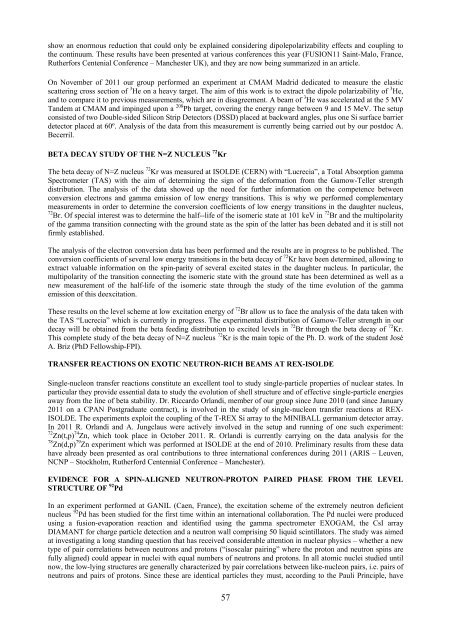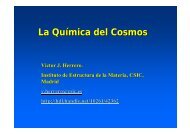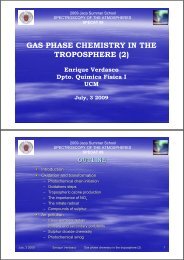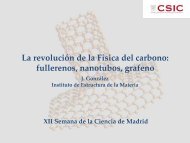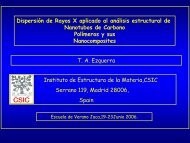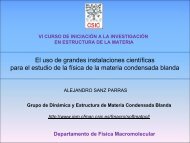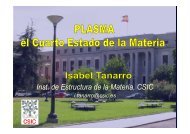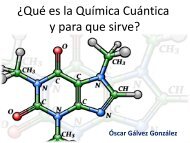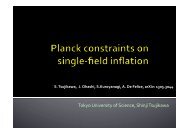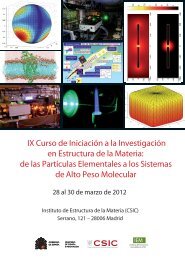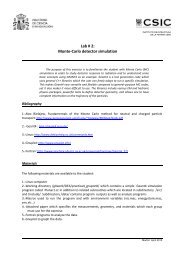ANNUAL REPORT 2011 - Instituto de Estructura de la Materia
ANNUAL REPORT 2011 - Instituto de Estructura de la Materia
ANNUAL REPORT 2011 - Instituto de Estructura de la Materia
You also want an ePaper? Increase the reach of your titles
YUMPU automatically turns print PDFs into web optimized ePapers that Google loves.
show an enormous reduction that could only be exp<strong>la</strong>ined consi<strong>de</strong>ring dipolepo<strong>la</strong>rizability effects and coupling tothe continuum. These results have been presented at various conferences this year (FUSION11 Saint-Malo, France,Rutherfors Centenial Conference – Manchester UK), and they are now being summarized in an article.On November of <strong>2011</strong> our group performed an experiment at CMAM Madrid <strong>de</strong>dicated to measure the e<strong>la</strong>sticscattering cross section of 3 He on a heavy target. The aim of this work is to extract the dipole po<strong>la</strong>rizability of 3 He,and to compare it to previous measurements, which are in disagreement. A beam of 3 He was accelerated at the 5 MVTan<strong>de</strong>m at CMAM and impinged upon a 208 Pb target, covering the energy range between 9 and 15 MeV. The setupconsisted of two Double-si<strong>de</strong>d Silicon Strip Detectors (DSSD) p<strong>la</strong>ced at backward angles, plus one Si surface barrier<strong>de</strong>tector p<strong>la</strong>ced at 60º. Analysis of the data from this measurement is currently being carried out by our postdoc A.Becerril.BETA DECAY STUDY OF THE N=Z NUCLEUS 72 KrThe beta <strong>de</strong>cay of N=Z nucleus 72 Kr was measured at ISOLDE (CERN) with “Lucrecia”, a Total Absorption gammaSpectrometer (TAS) with the aim of <strong>de</strong>termining the sign of the <strong>de</strong>formation from the Gamow-Teller strengthdistribution. The analysis of the data showed up the need for further information on the competence betweenconversion electrons and gamma emission of low energy transitions. This is why we performed complementarymeasurements in or<strong>de</strong>r to <strong>de</strong>termine the conversion coefficients of low energy transitions in the daughter nucleus,72 Br. Of special interest was to <strong>de</strong>termine the half--life of the isomeric state at 101 keV in 72 Br and the multipo<strong>la</strong>rityof the gamma transition connecting with the ground state as the spin of the <strong>la</strong>tter has been <strong>de</strong>bated and it is still notfirmly established.The analysis of the electron conversion data has been performed and the results are in progress to be published. Theconversion coefficients of several low energy transitions in the beta <strong>de</strong>cay of 72 Kr have been <strong>de</strong>termined, allowing toextract valuable information on the spin-parity of several excited states in the daughter nucleus. In particu<strong>la</strong>r, themultipo<strong>la</strong>rity of the transition connecting the isomeric state with the ground state has been <strong>de</strong>termined as well as anew measurement of the half-life of the isomeric state through the study of the time evolution of the gammaemission of this <strong>de</strong>excitation.These results on the level scheme at low excitation energy of 72 Br allow us to face the analysis of the data taken withthe TAS “Lucrecia” which is currently in progress. The experimental distribution of Gamow-Teller strength in our<strong>de</strong>cay will be obtained from the beta feeding distribution to excited levels in 72 Br through the beta <strong>de</strong>cay of 72 Kr.This complete study of the beta <strong>de</strong>cay of N=Z nucleus 72 Kr is the main topic of the Ph. D. work of the stu<strong>de</strong>nt JoséA. Briz (PhD Fellowship-FPI).TRANSFER REACTIONS ON EXOTIC NEUTRON-RICH BEAMS AT REX-ISOLDESingle-nucleon transfer reactions constitute an excellent tool to study single-particle properties of nuclear states. Inparticu<strong>la</strong>r they provi<strong>de</strong> essential data to study the evolution of shell structure and of effective single-particle energiesaway from the line of beta stability. Dr. Riccardo Or<strong>la</strong>ndi, member of our group since June 2010 (and since January<strong>2011</strong> on a CPAN Postgraduate contract), is involved in the study of single-nucleon transfer reactions at REX-ISOLDE. The experiments exploit the coupling of the T-REX Si array to the MINIBALL germanium <strong>de</strong>tector array.In <strong>2011</strong> R. Or<strong>la</strong>ndi and A. Jungc<strong>la</strong>us were actively involved in the setup and running of one such experiment:72 Zn(t,p) 74 Zn, which took p<strong>la</strong>ce in October <strong>2011</strong>. R. Or<strong>la</strong>ndi is currently carrying on the data analysis for the78 Zn(d,p) 79 Zn experiment which was performed at ISOLDE at the end of 2010. Preliminary results from these datahave already been presented as oral contributions to three international conferences during <strong>2011</strong> (ARIS – Leuven,NCNP – Stockholm, Rutherford Centennial Conference – Manchester).EVIDENCE FOR A SPIN-ALIGNED NEUTRON-PROTON PAIRED PHASE FROM THE LEVELSTRUCTURE OF 92 PdIn an experiment performed at GANIL (Caen, France), the excitation scheme of the extremely neutron <strong>de</strong>ficientnucleus 92 Pd has been studied for the first time within an international col<strong>la</strong>boration. The Pd nuclei were producedusing a fusion-evaporation reaction and i<strong>de</strong>ntified using the gamma spectrometer EXOGAM, the CsI arrayDIAMANT for charge particle <strong>de</strong>tection and a neutron wall comprising 50 liquid scintil<strong>la</strong>tors. The study was aimedat investigating a long standing question that has received consi<strong>de</strong>rable attention in nuclear physics – whether a newtype of pair corre<strong>la</strong>tions between neutrons and protons (“isosca<strong>la</strong>r pairing” where the proton and neutron spins arefully aligned) could appear in nuclei with equal numbers of neutrons and protons. In all atomic nuclei studied untilnow, the low-lying structures are generally characterized by pair corre<strong>la</strong>tions between like-nucleon pairs, i.e. pairs ofneutrons and pairs of protons. Since these are i<strong>de</strong>ntical particles they must, according to the Pauli Principle, have57


